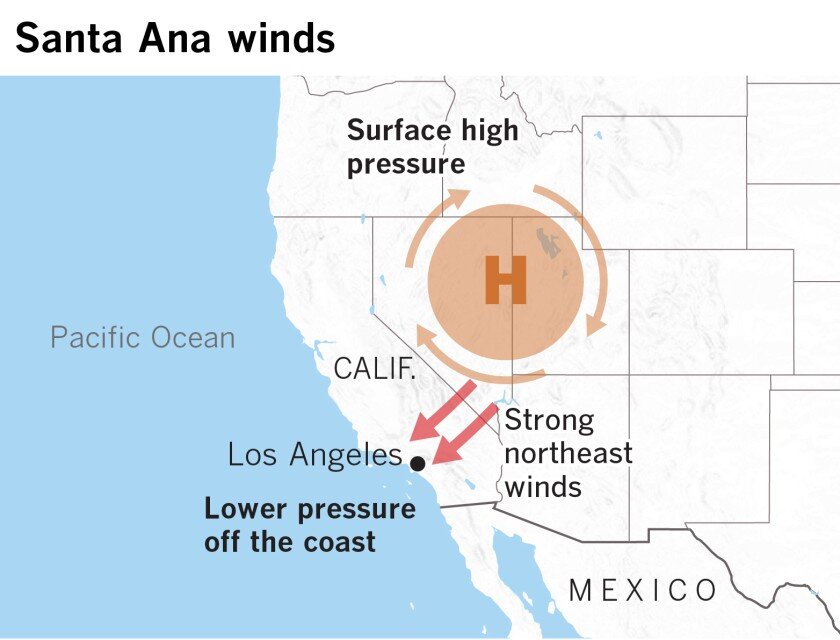Biodiversity & Environment
Wildfires in California
- 24 Aug 2020
- 5 min read
Why in News
California (USA) is facing sprawling wildfires destroying more than 400,000 acres of forests in Northern and Central California.
- The spark for many of these fires come from around 11,000 lightning strikes California has been hit by.
Key Points
- Historically, California has had many wildfires, which have increased manifold in recent times.
- The 10 largest fires have occurred since 2000, including the 2018 Mendocino Complex Fire, the largest in history of the USA..
- The frequency of western U.S. wildfires has increased by 400% since 1970.
- California has two distinct fire seasons:
- First or western fire season: From June through September
- Due to warmer and drier weather.
- Fires are more inland and in higher-elevation forests.
- Second Fire Season: From October through April
- Due to Santa Ana Winds.
- Burn closer to urban areas.
- Three times faster than first season fires
- Responsible for 80% of the economic losses over two decades
- First or western fire season: From June through September
- The winds' name derives its name from the Santa Ana canyon in Orange County, California.
- Santa Anas are dry, warm (often hot) winds that blow westward through Southern California toward the coast.
- They're usually seasonal, and typically occur between October and March and peak in December.
- They originate when high pressure systems form over the high-elevation deserts of the Great Basin between the Sierra Nevadas and the Rocky Mountains.
- As they flow downwards and cross desserts, they become very dry, warm, and gain speed. The lack of humidity in Santa Ana winds dries out vegetation, making it better fuel for a fire.
- The wind also fan the flames and helps spread them.
- Reasons for California’s Wildfires:
- Climate: California, like much of the West, gets most of its moisture in the fall and winter. Its vegetation then stays dry throughout the summer because of a lack of rainfall and warmer temperatures, which ultimately serves as ignition for fires.
- However with global warming, the temperature has increased by 1-2 degree Celsius, leading to an upsurge in cases of wildfires.
- Human intervention: The spark for many fires arise due to human-made causes such as fallen power lines, accidents etc.
- Due to urbanization, human habitation is increasingly moving areas near forests, known as the urban-wildland interface, that are inclined to burn.
- Suppressing Fires: Owing to suppression of natural fires artificially for a long time, which would consume the dry inflammable materials in the forest, a lot of dry material has accumulated causing even more fires.
- The United States Forest Service is now trying to rectify the previous practice through the use of prescribed or “controlled” or cool burning.
- Cool Burning : Cool burning is done in a controlled manner by artificially creating small, localised fires to limit the amount of vegetation available in any given area. It means that any fires will not have any build-up of “vegetative fuel” to use to become a large, uncontrollable fire.
- Santa Ana Winds: Santa Ana winds dry out vegetation and also move embers around, spreading fires.
- Climate: California, like much of the West, gets most of its moisture in the fall and winter. Its vegetation then stays dry throughout the summer because of a lack of rainfall and warmer temperatures, which ultimately serves as ignition for fires.
- Impact:
- Economic loss from destruction of life and property.
- Air pollution by small particulate matter and also acids, organic chemicals, and metals along with dust and allergens.
- Land degradation as high temperatures consume all nutrients and vegetation from a land, leaving it barren and infertile.
- Loss of biodiversity.
Way Forward
- Some immediate solutions to wildfires include not planting easily flammable tree species such as eucalyptus and pine in forest fire regions, not allowing human development near forest zones, and promoting policies that conserve water like waste-water recycling, desert landscaping, and low-water consumption appliances.
- However in long -term working on controlling greenhouse gas emission and thus, climate change is crucial to controlling such incidents which have affected the whole world and not just California. Recent Australian Bushfires, and Forest Fires in Uttarakhand are some other examples.







